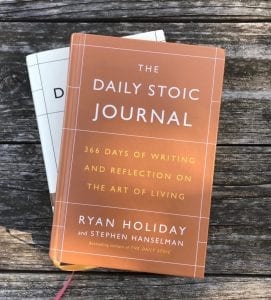Epictetus the slave. Marcus Aurelius the emperor. Seneca the power broker and playwright. These three radically different men led radically different lives. But they seemed to have one habit in common: Journaling.
In one form or another, each of them did it. It would be Epictetus who would admonish his students that philosophy was something they should “write down day by day,” that this writing was how they “should exercise themselves.” Seneca’s favorite time to journal was in the evenings. When darkness had fallen and his wife had gone asleep, he explained to a friend, “I examine my entire day and go back over what I’ve done and said, hiding nothing from myself, passing nothing by.” Then he would go to bed, finding that “the sleep which follows this self-examination” was particularly sweet. And Marcus, he was the most prodigious of journalers, and we are lucky enough that his writings survive to us, appropriately titled, Τὰ εἰς ἑαυτόν, Ta eis heauton, or “to himself.”
They were not the only ones to practice the habit of writing. Foucault observed of this era of history, all the great minds practiced it.
“In this period there was a culture of what could be called personal writing: taking notes on the reading, conversations, and reflections that one hears or engages in oneself; keeping kinds of notebooks on important subjects (what the Greeks called hupomnemata), which must be reread from time to time so as to re-actualize their contents.”
And of course, many people—Stoic or otherwise—have fallen in love with and dedicated themselves to morning or evening journaling in the centuries since. And for good reason—it works. It clarifies the mind, provides room for quiet, private reflection and gives one a record of their thoughts over time.
But in Stoicism the art of journaling is more than that, more than some simple diary. This daily practice is the philosophy. Preparing for the day ahead. Reflecting on the day that has passed. Reminding oneself of the wisdom we have learned from our teachers, from our reading, from our own experiences. It’s not enough to simply hear these lessons once, instead, one practices them over and over again, turns them over in their mind, and most importantly, writes them down and feels them flowing through their fingers in doing so.
In this way, journaling is Stoicism. It’s almost impossible to have one without the other.
So if you’re not doing it, please start! Whatever form you find is most conducive for you is the one to do it in. Some like to write or jot notes down on paper. Some like to pull up an empty document on their computer and record thoughts. But it is the process that counts.
And its value compounds over time. One cannot expect wisdom and self-mastery to simply arrive via epiphany. No, those states are acquired, little by little, practice by practice. The sooner you start, the better.

P.S. The Daily Stoic Journal perfectly merges Seneca’s style of reviewing the day just ending and Marcus’s preparation for the day to come and is filled with new weekly meditations of Stoicism and daily prompts (that work alongside this email and The Daily Stoic book). We hope you’ll check it out!
Explore Our Daily Stoic Store